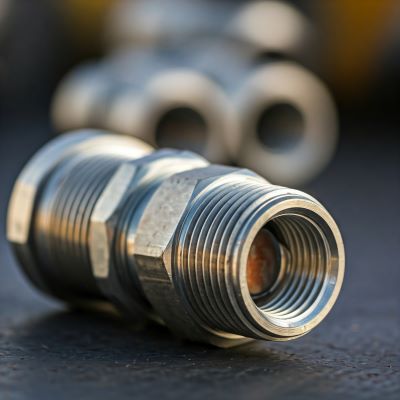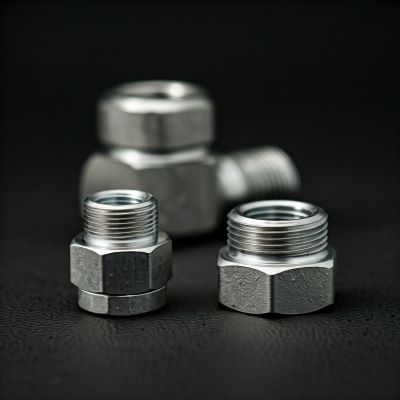The choice between UNC and UNF threads can significantly impact the performance, durability, and overall functionality of a mechanical assembly. By comprehending the unique characteristics and applications of each thread type, engineers can make informed decisions that optimize the design and enhance the reliability of their projects.
What Are UNC and UNF Threads?
UNC threads, as the name suggests, are characterized by a relatively coarse pitch, meaning the distance between adjacent thread crests is larger. This design offers several advantages, particularly in applications where ease of assembly and disassembly is prioritized.
In contrast, UNF threads feature a finer pitch, resulting in more threads per inch. This finer spacing provides enhanced precision and resistance to vibration, making UNF threads ideal for applications demanding high levels of accuracy and durability.
Key Characteristics of UNC Threads
The thread pitch refers to the distance between two adjacent threads measured along the axis of the screw. UNC threads have a larger thread pitch compared to UNF threads.
Advantages of UNC Threads in Industrial Applications
➡️ Ease of assembly and disassembly
➡️ Reduced risk of thread stripping during installation
➡️ Suitable for applications where vibration is not a major concern
Common Uses of UNC Threads in Manufacturing and Construction
➡️ General-purpose fastening applications
➡️ Woodworking and furniture assembly
➡️ Plumbing and pipe fittings
Key Characteristics of UNF Threads
UNF threads boast a finer pitch, resulting in a greater number of threads per inch. This finer spacing provides several benefits, including enhanced resistance to vibration and improved load-bearing capacity.
Benefits of UNF Threads for Precision and Secure Fastening
➡️ Increased resistance to vibration and loosening
➡️ Enhanced load-bearing capacity
➡️ Perfect for uses that demand a high degree of accuracy and robustness
Typical Applications of UNF Threads in Aerospace and Automotive Industries
➡️ Aerospace components
➡️ Automotive engine parts
➡️ Precision machinery
Comparative Analysis: UNC vs UNF
Thread Pitch Differences and Their Impact on Performance
Thread pitch is the main way that UNC and UNF threads differ from one another. UNC threads have a coarser pitch, while UNF threads have a finer pitch. This difference in pitch significantly influences the performance characteristics of each thread type.
Strength and Durability Comparison Between UNC and UNF
UNF threads generally exhibit superior strength and durability due to their finer pitch, which provides a larger contact area between the threads. This increased contact area translates to improved load-bearing capacity and resistance to vibration.
Use Case Scenarios: When to Choose UNC or UNF Threads
The particular needs of the application will determine whether to use UNC or UNF threads. UNC threads are typically preferred for general-purpose applications where ease of assembly and disassembly is paramount. Conversely, UNF threads are ideal for applications demanding high levels of precision, vibration resistance, and load-bearing capacity.
Material Compatibility with UNC and UNF Threads
How Thread Types Affect Material Choices
The selection of materials for UNC and UNF threads should consider factors such as strength, corrosion resistance, and compatibility with the intended application. Materials commonly used for UNC and UNF threads include steel, stainless steel, aluminum, and brass.
Examples of Compatible Materials for UNC and UNF Applications
➡️ Steel: Widely used for its strength and versatility
➡️ Stainless Steel: Offers excellent corrosion resistance
➡️ Aluminum: Lightweight and appropriate for uses where reducing weight is essential
➡️ Brass: Provides good machinability and corrosion resistance
Common Tools and Gauges for Thread Measurement
Essential Tools for Measuring Thread Pitch and Size
Accurate thread measurement is crucial to ensure proper fit and function. Common tools used for measuring thread pitch and size include:
➡️ Thread pitch gauges: These tools have a series of blades with different pitches, allowing for quick and easy identification of the thread type.
➡️ Micrometers: Precise measuring instruments used to determine the diameter of the thread.
➡️ Calipers: Versatile tools for measuring both internal and external dimensions of threads.
Tips for Ensuring Accurate Identification of UNC and UNF Threads
To accurately identify UNC and UNF threads, it is essential to use appropriate measuring tools and techniques. Refer to the Unified Thread Standard (UTS) for precise specifications and ensure proper tool calibration for accurate measurements.
Advantages and Disadvantages of Each Thread Type
Pros and Cons of Using UNC Threads in Various Industries
➡️ Advantages: Ease of assembly and disassembly, reduced risk of thread stripping.
➡️ Disadvantages: Lower resistance to vibration and loosening, limited load-bearing capacity.
Pros and Cons of Using UNF Threads for Precision Tasks
➡️ Advantages: Enhanced precision, increased resistance to vibration and loosening, higher load-bearing capacity.
➡️ Disadvantages: More challenging to assemble and disassemble, increased risk of thread stripping during installation.
How to Pick the Best Thread for Your Requirements
Factors to Consider When Selecting Between UNC and UNF Threads
When selecting between UNC and UNF threads, consider the following factors:
➡️ The specific requirements of the application, including load-bearing capacity, vibration resistance, and ease of assembly.
➡️ The materials used for the components being connected.
➡️ The desired level of precision and durability.
Guidelines for Making Informed Decisions in Specific Projects
Consult with experienced engineers and refer to the Unified Thread Standard (UTS) for guidance when making decisions about thread selection. Consider the potential consequences of using the wrong thread type, such as premature failure or compromised performance.
Check out these other resources for your gain ⬇️⬇️⬇️
Choosing Between NPTF vs NPT Threads [Made Simple]
Key Differences Between BSPP and BSPT Threads
Practical Tips for Working with UNC and UNF Threads
Best Practices for Threading and Fastening
➡️ Use appropriate tools and techniques to ensure proper thread engagement.
➡️ Avoid excessive force during assembly to prevent thread stripping.
➡️ Apply thread lubricant to facilitate installation and reduce friction.
Maintenance Tips to Ensure Thread Integrity Over Time
➡️ Regularly inspect threaded connections for signs of wear or damage.
➡️ Periodically retighten fasteners to maintain proper tension.
➡️ Use appropriate cleaning and lubrication methods to prevent corrosion and maintain thread integrity.
Conclusion
UNC and UNF threads are two common thread types defined by the Unified Thread Standard (UTS). UNC threads have a coarser pitch, offering ease of assembly and disassembly. UNF threads, on the other hand, feature a finer pitch, providing enhanced precision, vibration resistance, and load-bearing capacity.
Selecting the appropriate thread type is crucial for ensuring the optimal performance and longevity of mechanical assemblies. By understanding the unique characteristics and applications of UNC and UNF threads, engineers can make informed decisions that enhance the reliability and efficiency of their designs.
Prioritize precision and application-specific needs when selecting thread types. By carefully considering the factors discussed in this blog post, you can make informed decisions that contribute to the success of your projects.
Post time: Jan-07-2025



